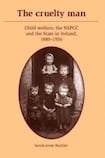
‘He took a step to the door and seized the walking-stick which was standing behind it.
“ ‘I’ll teach you to let the fire out!’ he said, rolling up his sleeve in order to give his arm free play.
“The little boy cried ‘O, pa!’ and ran whimpering round the table, but the man followed him and caught him by the coat. The little boy looked about him wildly but, seeing no way of escape, fell upon his knees.
“ ‘Now, you’ll let the fire out the next time!’ said the man striking at him vigorously with the stick. ‘Take that, you little whelp!’
“The boy uttered a squeal of pain as the stick cut his thigh. He clasped his hands together in the air and his voice shook with fright.
“ ‘O, pa!’ he cried. ‘Don’t beat me, pa! And I’ll . . . I’ll say a Hail Mary for you . . . I’ll say a Hail Mary for you, pa, if you don’t beat me . . . I’ll say a Hail Mary . . .’ ”
Thus the ending of Counterparts , one of the stories from James Joyce's Dubliners , providing a vivid description of a child being beaten by his drunken father. Farrington, a frustrated and alcoholic solicitor's clerk, has had a bad day at work and a worse evening out with his drinking companions, having pawned his watch and been defeated twice at arm-wrestling. He comes home to find the house in darkness and the fire out, and takes his rage out on Tom, one of his children, who has the task of cooking his dinner.
When Joyce wrote this story, in 1906, the National Society for the Prevention of Cruelty to Children was already well established in Dublin. The first society of this kind had been set up in New York in 1874, on foot of the abuse of a 10-year-old child, Mary Ellen McCormack, by her foster mother, and the discovery that the only way to remove her from this situation was to take refuge in the laws against cruelty to animals, as no such laws existed to protect children. The movement quickly spread to the UK, and the Irish branch of the society was formed in 1889.
Sarah-Anne Buckley’s book uses the surviving fragmentary archives of the NSPCC (later the ISPCC) to track the society’s activities up to the 1950s, although the bulk of the archival material deals with the 1930s and 1940s.
It forms an important part of the growing body of work on child welfare in Ireland, work given a public face by Mary Raftery's pioneering television series States of Fear (1996), which focused on the experiences of adults who as children had been incarcerated, abused and neglected in Ireland's extensive network of industrial schools, and whose voices were finally being heard.
Buckley tracks the development of the society from its early days, through the turbulent years of world war and nationalist conflict, into the early days of the Free State and, finally, to the beginning of the 1950s.
She contextualises its activities, both interventionist (often removing children from their homes) and advisory (helping women with violent husbands, and giving advice on accessing such material supports as were available), by discussing the framework of child-welfare legislation constructed in the UK in the late 19th and early 20th centuries, and the glaring lack of any developmental legislation in Ireland after independence; the UK continued to develop its thinking on children’s needs, particularly by closing down the industrial-school system that Ireland notoriously retained until quite recently.
In post-independence Ireland the NSPCC was in increasing competition with the Society of St Vincent de Paul and the Legion of Mary, both with an overwhelmingly Catholic ethos and a strong mission against proselytism – the saving of souls taking precedence over other considerations. Buckley rightly points out the State’s reliance on private charities to deliver services to the vulnerable, a situation that persists today, as recent controversies about the pay of charity chief executives can attest.
Buckley correctly identifies class and gender as moving forces behind the society’s activities: its efforts were solely directed at poor or working-class families and, although motivated by excellent intentions towards vulnerable children, had the disastrous effect of ensuring the incarceration of many of them in institutions where they were treated at least as badly as in their homes.
And although attitudes to mothers changed quite substantially, they were still the focus of seriously intrusive investigation and accusation by an all-male, very well-paid inspectorate. These were hazards of the time, but it’s important to be clear about their consequences.
One of the problems with the book is that we get to know next to nothing about the members of the organisation or its inspectors. They are presented through the prism of their activities, and even those are restricted to what archives survive. (The fullest survival is for Co Wexford.)
Buckley’s thesis would be enhanced by an exploration of the background, education, occupations, religious status and family arrangements of the “cruelty men”. Also, it would have been useful to get a clear understanding of the funding and financial management of the society over the years; do annual accounts or subscription lists survive? Who gave them money (vague descriptions like “the Anglo-Irish” are not enough), and how did they spend and account for it?
Buckley ends the book with a warning that child welfare in Ireland is still a very troubled area. The reports of the Ombudsman for Children ominously bear this out.
Horrendous events like the Kilkenny incest case, the Joseph McColgan case and the Roscommon abuse case prove that some parents think their children are their property, to do with as they please, and that the State’s responses to such horrors can be dangerously lacking in urgency. The broader debate about voluntary philanthropy and State responsibility continues. Meanwhile, one of the main reasons for child neglect, systemic poverty, gets worse.










